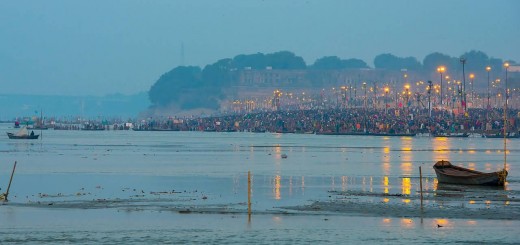15 Rarely Known World Heritage Sites In India

Krishna Pushkarani Hampi Ruins (Photo Credit: Dey.sandip / CC BY-SA 3.0)
Group of Monuments at Hampi, Karnataka
Hampi is a village in northern Karnataka, India. It was one of the richest and largest cities in the world during its prime. The name Hampi can also mean “champion”. It is located within the ruins of the city of Vijayanagara. Predating the city of Vijayanagara, it continues to be an important religious centre, housing the Virupaksha Temple as well as several other monuments belonging to the old glorious city. The ruins are a UNESCO World Heritage Site, listed as the Group of Monuments at Hampi.
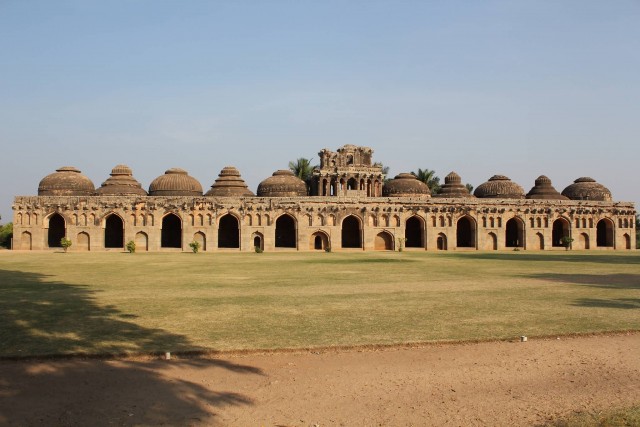
Elephant Stables, Hampi (Photo Credit: Arian Zwegers / CC BY 2.0)
According to statistics of 2014, Hampi is the most searched historical place in Karnataka on Google. In around 1500 AD Hampi had about 500,000 inhabitants, making it the second largest city in the world after Peking-Beijing and almost thrice the size of Paris. Hampi is situated on the banks of the Tungabhadra river. The city of Vijayanagara was originally encompassed by seven lines of fortifications. These fortifications had a large number of bastions and gateways. The seventh & the innermost fortification enclosed the main city & is the best preserved.

The Mandapas Of Vittala Temple (Photo Credit: Srikar.agnihotram / CC BY-SA 3.0)
Kaziranga National Park, Assam

Kaziranga National Park (Photo Credit: Satish Krishnamurthy / CC BY 2.0)
Kaziranga National Park is an Indian national park and an UNESCO World Heritage Site situated in the Golaghat and Nagaon district of Assam, India. It is a tourist destination and conservation area particularly notable as a refuge for the endangered Indian one-horned rhinoceros, hosting the largest population of wild Indian one-horned Rhinoceros in the world. The park contains significant stock of three other large herbivores – the Asian Elephant, the Asiatic Water Buffalo and the eastern subspecies of the Swamp Deer.

Elephant In Kaziranga National Park (Photo Credit: Chiring chandan / CC BY 3.0)
Kaziranga also has the highest density of tiger in the world and is declared a Tiger Reserve in 2006. Kaziranga is recognized as an Important Bird Area by Birdlife International for conservation of avifaunal species. Compared to other protected areas in India, Kaziranga has achieved notable success in wildlife conservation. Kaziranga is a vast expanse of tall elephant grass, marshland and dense tropical moist broadleaf forests, crisscrossed by four major rivers, including the Brahmaputra and the park includes numerous small bodies of water.

Flooded Grasslands In The Kaziranga National Park (Photo Credit: Peter Andersen / CC BY-SA 3.0)
Manas National Park, Assam

Manas National Park (Photo Credit: Sougata Sinha Roy / CC BY 3.0)
Manas National Park or Manas Wildlife Sanctuary is a National Park, UNESCO Natural World Heritage site, a Project Tiger Reserve, an Elephant Reserve and a Biosphere Reserve in Assam, India. It is located in the Himalayan foothills, it is adjacent with the Royal Manas National Park in Bhutan. The park is known for its rare and endangered endemic wildlife such as the Assam Roofed Turtle, Hispid Hare, Golden Langur and Pygmy Hog. Manas is famous for its population of the Wild water buffalo.

On The Periphery Of Manas National Park (Photo Credit: Chandrashekhar Basumatary / CC BY 2.0)
The Manas National Park was declared a sanctuary on October 1, 1928 with an area of 360 km². It was declared a World Heritage site in December 1985 by UNESCO. Kahitama R.F. the Kokilabari R.F. and the Panbari R.F. were added in the year 1990 to form the Manas National Park. In 1992, UNESCO declared it as a world heritage site in danger due to heavy poaching and terrorist activities. In 25 February 2008 the area was increased to 950 km². On 21 June 2011, it was removed from the List of World Heritage in Danger and was commended for its efforts in preservation.

A View Of Mountains From The Park (Photo Credit: Chandrashekhar Basumatary / CC BY 2.0)
Mahabodhi Temple at Bodh Gaya, Bihar

Mahabodhi Temple With Monks (Photo Credit: Evan Lovely / CC BY 2.0)
The Mahabodhi Temple, Literally meaning is “Great Awakening Temple”. It is a UNESCO World Heritage Site. It is a Buddhist temple in Bodh Gaya, marking the location where Siddhartha Gautama, the Buddha is said to have attained enlightenment. Bodh Gaya is located about 96 km from Patna, Bihar state, India. The complex was primarily a Mahayana site. The Bodhi tree at Bodhgaya is directly connected to the life of the historical Buddha, Siddhartha Gautama, who attained enlightenment or perfect insight when he was meditating under it. The temple was build directly to the east of the Bodhi tree.

Golden Buddha In Mahabodhi Temple, Bodh Gaya (Photo Credit: Ken Wieland / CC BY-SA 2.0)
About 200 years after the Buddha attained Enlightenment, Buddhist Emperor Asoka visited Bodh Gaya in order to establish a monastery and shrine on the holy site. Mahabodhi Temple is constructed of brick and is one of the oldest brick structures to have survived in eastern India. It is considered to be a fine example of Indian brickwork. According UNESCO, “the present temple is one of the earliest and most imposing structures built entirely in brick from Gupta period”. In June 2002, the Mahabodhi Temple became a UNESCO World Heritage Site.

Mahabodhi Temple Complex, Bodh Gaya (Photo Credit: Matt Stabile / CC BY 2.0)
Sun Temple at Konark, Odisha

A View From The Temple Entrance (Photo Credit: Santosh.pati / CC BY-SA 3.0)
Konark Sun Temple is a 13th-century Sun Temple at Konark, in Odisha, India. It is believed that the temple was built by king Narasimhadeva I of Eastern Ganga Dynasty around AD 1250. The temple is in the shape of a gigantic chariot with elaborately carved stone wheels, pillars and walls. A major part of the structure is now in ruins. The temple is a UNESCO World Heritage Site. It is also featured on NDTV’s list of Seven Wonders of India and Times of India’s list of Seven Wonders of India. The name Konark derives from the combination of the Sanskrit words, Kona (corner) and Arka (sun), in reference to the temple which was dedicated to the Sun god Surya.

Dance Pavilion (Nata Mandir) In Sun Temple (Photo Credit: Bernard Gagnon / CC BY-SA 1.0)
The temple was originally built at the mouth of the river Chandrabhaga, but the waterline has receded since then. The temple has been built in the form of a giant ornamented chariot of the Sun god, Surya. It has twelve pairs of elaborately carved stone wheels which are 3 meters wide and is pulled by a set of seven horses. The temple follows the traditional style of Kalinga architecture. The Konark temple is also known for its erotic sculptures of maithunas.

Konark Sun Temple (Photo Credit: Amitavamarine007 / CC BY-SA 3.0)
Champaner-Pavagadh Archaeological Park, Gujarat

Panch Mahuda Ki Masjid (Photo Credit: Dipesh Bhatt / CC BY-SA 3.0)
Champaner-Pavagadh Archaeological Park is a UNESCO World Heritage Site. It is located in Panchmahal district in Gujarat, India. It is located around the historical city of Champaner. The heritage site is studded with forts with bastions starting from the hills of Pavagadh and extending into the city of Champaner. The park’s landscape includes archaeological, historic and living cultural heritage monuments such as chalcolithic sites, a hill fortress of an early Hindu capital and remains of the 16th-century capital of the state of Gujarat.

Sahar Ki Masjid, Champaner, Gujarat (Photo Credit: Digishagautam / CC BY-SA 3.0)
The Champaner-Pavagadh heritage site is spread over an area of more than 1,329 hectares. There are palaces, entrance gates and arches, mosques, tombs and temples, residential complexes, agricultural structures and water installations such as stepwells and tanks. The transition between Hindu and Muslim culture and architecture in the late 15th to early 16th century is documented in the park, particularly the early Islamic and pre-Mughal city that has remained without any change. It was inscribed by UNESCO as a World Heritage Site in 2004.

Jami Masjid, Champaner , Gujarat (Photo Credit: Shravani / CC BY-SA 3.0)
Group of Monuments at Pattadakal, Karnataka

Monuments At Pattadakal (Photo Credit: Nithin bolar k / CC BY-SA 3.0)
Pattadakal also spelled Pattadakalu is a World Heritage site. It is a village and an important tourist centre in the state of Karnataka and is located on the left bank of the Malaprabha River in Bagalkot district. It is 22 km from Badami and about 10 km from Aihole, both of which are well known for Chalukya monuments. The Pre-Chalukya historical and Archaeological site Bachinagudda is also near Pattadakal. There are ten temples at Pattadakal, including a Jain sanctuary surrounded by numerous small shrines and plinths in fusion of various Indian architectural styles.

Monuments At Pattadakal (Photo Credit: Shashidhara halady / CC BY-SA 4.0)
UNESCO in 1987 included Pattadakal in its list of World Heritage sites. The group of 8th century monuments in Pattadakal are the culmination of the earliest experiments in the vesara style of Hindu temple architecture. The town displays both Dravidian (Southern) and the Nagara (Northern) styles of temple architecture. There are groups of monuments – Virupaksha Temple, Sangameshvara Temple, Chandrashekhara temple, Mallikarjuna Temple, Kashivisvanatha Temple, Galganatha temple, Jain Temple etc.

Virupaksha Temple At Pattadakal (Photo Credit: Dineshkannambadi / CC BY-SA 3.0)
Buddhist Monuments at Sanchi, Madhya Pradesh

The Great Stupa At Sanchi (Photo Credit: Jean-Pierre Dalbéra / CC BY 2.0)
The Buddhist vihara at Sanchi is a famous for its Great Stupa. It is located at Sanchi Town in Madhya Pradesh, India. The Great Stupa at Sanchi is the oldest stone structure in India and it was originally commissioned by the emperor Ashoka the Great in the 3rd century BCE.
The construction work of this stupa was overseen by Ashoka’s wife, Devi herself, who was the daughter of a merchant of Vidisha. Sanchi was also her birthplace as well as the venue of her and Ashoka’s wedding. Today, around fifty monuments remain on the hill of Sanchi, including three stupas and several temples. The monuments have been listed among the UNESCO World Heritage Sites since 1989.

Group Of Smaller Stupas At Sanchi (Photo Credit: Nandanupadhyay / CC BY-SA 3.0)
Keoladeo National Park, Rajasthan

A View Of The Bharatpur Bird Sanctuary (Photo Credit: Anupom sarmah / CC BY-SA 4.0)
The Keoladeo National Park is formerly known as the Bharatpur Bird Sanctuary in Bharatpur Indian state of Rajasthan. It is a famous avifauna sanctuary that plays host to thousands of birds especially during the winter season. Over 230 species of birds are known to have made the National Park their home. It is also a major tourist centre with scores of ornithologists arriving here in the hibernal season. It was declared a protected sanctuary in 1971. In 1985, the Park was declared a World Heritage Site under the world Heritage Convention. The sanctuary was created 250 years ago and is named after a Keoladeo (Shiva) temple within its boundaries.
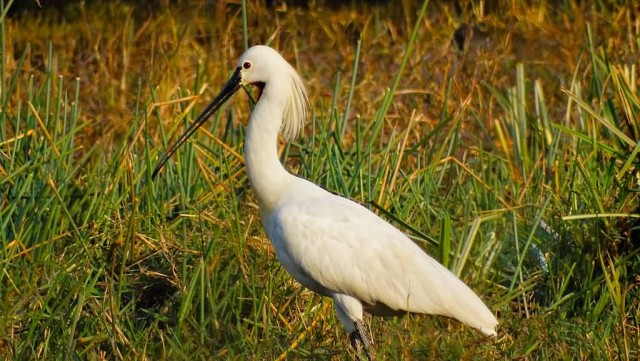
Eurasian Spoonbill (Photo Credit: Anupom sarmah / CC BY-SA 4.0)
Every year thousands of migratory waterfowl visit the park for wintering breeding etc. The Sanctuary is one of the richest bird areas in the world. It is known for nesting of its resident birds and visiting migratory birds including water birds. The rare Siberian cranes used to winter in this park but this central population of Siberian cranes is now extinct. According to Sir Peter Scott Keoladeo Sanctuary is the world’s best bird area.

Keoladeu National Park (Photo Credit: Anupom sarmah / CC BY-SA 4.0)
Jantar Mantar at Jaipur, Rajasthan

Jantar Mantar Observatory (Photo Credit: McKay Savage / CC BY 2.0)
The Jantar Mantar monument of Jaipur, Rajasthan is a collection of 19th architectural astronomical instruments. It built by the Rajput king Sawai Jai Singh and completed in 1738 CE. It features the world’s largest stone sundial and is a UNESCO World Heritage site. It is located near City Palace and Hawa Mahal of Jaipur. Jantar Mantar is managed under the Archeological Sites and Monuments Act of Rajasthan since 1961 and protected as a National Monument of Rajasthan since 1968.

Jantar Mantar (Photo Credit: Wikipedia / CC BY-SA 3.0)
The monument features instruments operating in each of the three main classical celestial coordinate systems: the horizon-zenith local system, the equatorial system and the ecliptic system. The monument was damaged in the 19th century. The word jantar mantar originally meant Yantra Mantra that is instrument and power which later in the local language started to be called jantar mantar.
Great Living Chola Temples at Darasuram, Tamil Nadu
The Great Living Chola Temples are temples built during the Chola rule in the south of India. These temples are the Brihadisvara Temple at Thanjavur, the Temple of Gangaikonda Cholapuram and the Airavatesvara Temple at Darasuram. The Brihadisvara Temple was declared by UNESCO as a World Heritage Site in 1987. The site is now known as the “Great Living Chola Temples”.

Airavatesvara Temple Entrance (Photo Credit: Supraja kannan / CC BY-SA 4.0)
There are four criteria for being “Great Living Chola Temples”:
Criterion (i): The three Chola temples of Southern India represent an outstanding creative achievement in the architectural conception of the pure form of the dravida type of temple.
Criterion (ii): The Brihadisvara Temple at Thanjavur became the first great example of the Chola temples, followed by a development of which the other two properties also bear witness.
Criterion (iii): The three Great Chola Temples are an exceptional and the most outstanding testimony to the development of the architecture of the Chola Empire and the Tamil civilisation in Southern India.
Criterion (iv): The Great Chola temples at Thanjavur at Gangaikondacholapuram and Darasuram are outstanding examples of the architecture and the representation of the Chola ideology.

Gangaikonda Cholapuram (Photo Credit: Kasiarunachalam / CC BY-SA 3.0)
Mountain Railways of India

Railway On Batasia Loop (Photo Credit: A.M.Hurrell / CC BY-SA 3.0)
Mountain railways of India are the six or seven lines. It built during the 19th and early 20th century of British colonial rule. These lines have been running since then. Today the Indian Railways runs them, along with the Kashmir Railway since 2005. The Darjeeling Himalayan Railway in 1999, the Nilgiri Mountain Railway in 2005 and the Kalka–Shimla Railway in 2008 have collectively been designated as a UNESCO World Heritage Site.

Nilgiri Mountain Railway (Photo Credit: Nsmohan / CC BY-SA 4.0)
These lines connect important hill resorts with the foot hills, winding their way up through rugged yet scenic mountainous landscape. The three together have been titled as “Mountain Railways of India” under Criteria : ii, iv under the region in the Asia-Pacific. Bilaspur-Mandi-Leh Railway is expected to become the highest railway track in the world by its completion overtaking the current record of China’s Qinghai-Tibet Railway.

Himalayan Queen Train Entering In Tunnel (Photo Credit: Raghavan V / CC BY-SA 3.0)
Western Ghats
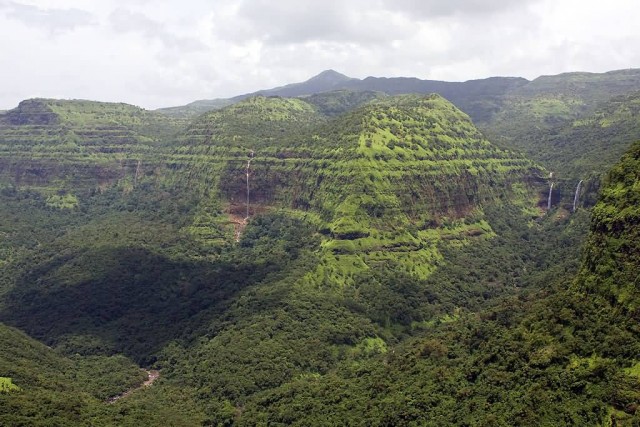
Western Ghat (Photo Credit: Cj.samson / GFDL)
The Western Ghats or Sahyadri are a mountain range that runs almost parallel to the western coast of the Indian peninsula, located entirely in India. It is a UNESCO World Heritage Site and is one of the eight “hottest hotspots” of biological diversity in the world. It is sometimes called the Great Escarpment of India. The range starts near the border of Gujarat and Maharashtra, south of the Tapti river and runs approximately 1,600 km through the states of Maharashtra, Goa, Karnataka, Kerala and Tamil Nadu ending at Kanyakumari at the southern tip of India.
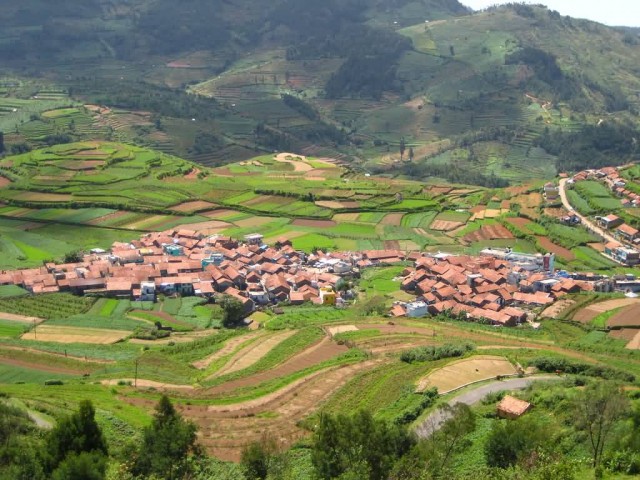
Western Ghat (Photo Credit: Technofreak / CC BY-SA 2.0)
The Western Ghats form one of the four watersheds of India, include the Godavari, Tungabhadra River, Krishna and Kaveri. In 2006, India applied to the UNESCO MAB for the Western Ghats to be listed as a protected World Heritage Site. In 2012, 39 places are declared as World Heritage Sites.

Western Ghat (Photo Credit: Karunakar Rayker / CC BY 2.0)
Rani ki vav at Patan, Gujarat

Rani Ki Vav (Photo Credit: Bernard Gagnon / CC BY-SA 1.0)
Rani ki vav is an intricately constructed stepwell situated in the town of Patan in Gujarat, India. It was added to the list of UNESCO’s World Heritage Sites on 22 June 2014. Rani ki vav (Queen’s step well) was constructed during the rule of the Solanki dynasty. The stepwell was later flooded by the nearby Saraswati River and silted over until the late 1980’s.

Beautiful Stone Carving, Side Walls Of Step Well (Photo Credit: Harsh Patel / CC BY-SA 3.0)
When it was excavated by the Archeological Survey of India, the carvings were found in pristine condition. This magnificent east-facing step well measures approximately 64m long, 20m wide & 27m deep. A stepped corridor compartmented at regular intervals pillared multistory pavilions is a unique feature. It was one of the largest and the most sumptuous structures of its type. It became silted up and much of it is not visible now, except for some rows of sculptured panels in the circular part of the well. Among its ruins one pillar still stands which is an excellent example of this period of design.

Rani Ki Vav (Photo Credit: Bernard Gagnon / CC BY-SA 1.0)
Great Himalayan National Park, Himachal Pradesh

Dhauladhar Ranges In The Background (Photo Credit: J.M.Garg / CC BY-SA 3.0)
The Great Himalayan National Park is one of India’s national parks. It is located in Kullu region in the state of Himachal Pradesh. The park was established in 1984 and is spread over an area of 1,171 km2. The Great Himalayan National Park is a habitat to numerous flora and more than 375 fauna species, including approximately 31 mammals, 181 birds, 3 reptiles, 9 amphibians, 11 annelids, 17 mollusks and 127 insects. They are protected under the strict guidelines of the Wildlife Protection Act of 1972. Hence any sort of hunting is not permitted.
In June 2014, the Great Himalayan National Park was added to the UNESCO list of World Heritage Sites. The UNESCO World Heritage Site Committee granted the status to the park under the criteria of “exceptional natural beauty and conservation of biological diversity”.
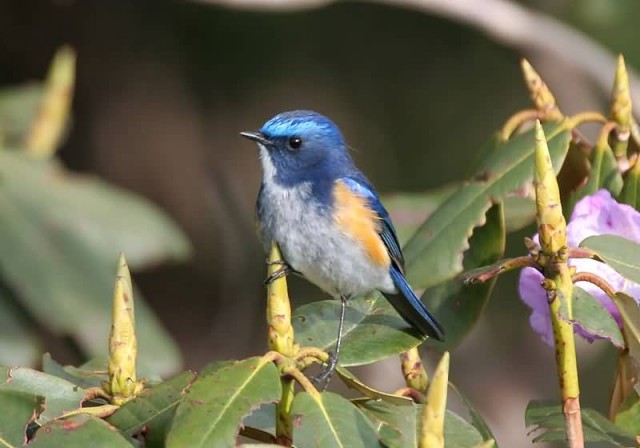
Himalayan Bluetail Tarsiger Rufilatus In Kullu (Photo Credit: J.M.Garg / CC BY-SA 3.0)














